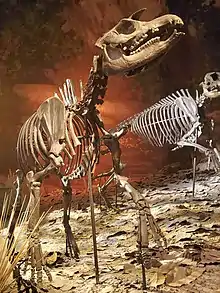| Tapirus polkensis Temporal range: | |
|---|---|
 | |
| Fossil replicas on display at the Gray Fossil Site & Museum | |
| Scientific classification | |
| Domain: | Eukaryota |
| Kingdom: | Animalia |
| Phylum: | Chordata |
| Class: | Mammalia |
| Order: | Perissodactyla |
| Family: | Tapiridae |
| Genus: | Tapirus |
| Species: | †T. polkensis |
| Binomial name | |
| †Tapirus polkensis Olsen, 1960 | |
Tapirus polkensis, the pygmy tapir, is a small prehistoric tapir that lived in North America during the late Miocene and early Pliocene.[1] T. polkensis had an estimated mass of around 125 kg (276 lb),[1] making it smaller than any extant tapir.
The Gray Fossil Site in northeast Tennessee is home to the world's largest known fossil assemblage of T. polkensis.
References
- 1 2 Richard C. Hulbert Jr.; Steven C. Wallace; Walter E. Klippel & Paul W. Parmalee (2009). "Cranial morphology and systematics of an extraordinary sample of the Late Neogene dwarf tapir, Tapirus polkensis (Olsen)". Journal of Paleontology. 83 (2): 238–262. doi:10.1666/08-062.1.
This article is issued from Wikipedia. The text is licensed under Creative Commons - Attribution - Sharealike. Additional terms may apply for the media files.
